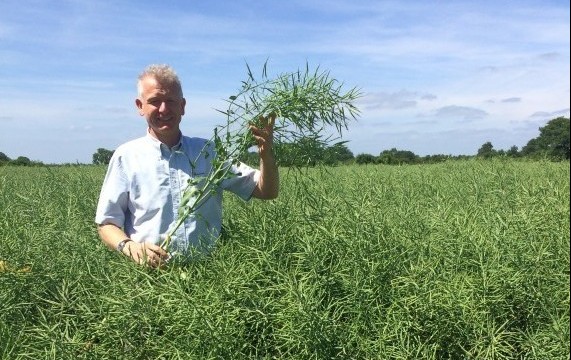There are now 14 varieties available from a number of different breeders, including Grainseed. It is anticipated that more farmers will try out the Clearfield system this year, to rid themselves of difficult weeds such as charlock, hedge mustard and runch or as a prophylactic approach to making sure the seed sample does not exceed the necessary erucic acid levels, which currently stand at 5% in oil but are likely to be reduced to 2% in the near future. But some farmers are still reluctant to try it out because they think yields are compromised.
“That may have been a valid worry in the early days but not now. The modern generation of Clearfield varieties have shot up in terms of yield,” says Neil Groom, technical director for Grainseed. “The earlier Clearfield varieties did struggle to compete with non-Clearfield ones on yield but this is not the case for the newer ones such as Es Decibel CL. In NIABTAG trials, the Grainseed variety Es Decibel CL was the top yielding Clearfield variety out of 16 varieties tested, averaging a yield of 106% (4.41 t/ha) across 7 trial sites harvested in 2017 and 2018. If growers want the advantages of the Clearfield system plus yield, then they should be growing this variety.”
Neil explains that Clearfield is a unique system for winter oilseed rape that combines hybrid seed varieties and the use of high quality BASF herbicides – Cleranda (imazamox + metazachlor) or Cleravo (imazamox + quinmerac). Using conventional breeding techniques, varieties have been bred to develop tolerance to Clearfield herbicides. By applying these herbicides post-emergence, all weeds and volunteer rape can be controlled. “This means growers can use Clearfield as a management tool, bringing fields back into rotation and allowing rape to be grown profitably where it would have been difficult or impossible to do so.”
Neil notes that this season relying on bifenox to control charlock in winter oilseed rape has been a risk because the long, mild winter in which crops have taken a while to wax up effectively. Bifenox is a PPO herbicide and is a strong contact acting product. This year charlock plants have come through this herbicide treatment and are now coming into flower. These weeds will pollinate and produce seed high in erucic acid (charlock has 31.7% erucic acid) and seeds could act as a contaminant. The solution to this problem is to move to Clearfield oilseed rape.
Neil Groom says when growing Es Decibel CL, growers get the best of all worlds, benefitting from the advantages of Clearfield whilst growing a high yielding variety. “By applying post-emergence Clearfield herbicides to Clearfield rape, difficult cruciferous broad-leaved weeds or volunteer rape are killed but the Clearfield rape is left unaffected to grow. Some cruciferous weeds have high levels of erucic acid and need to be controlled because they can affect levels in the sample at the crush. Currently UK and EU legislation sets a limit of 5% erucic acid in foodstuffs but this is likely to be reduced to 2% before next season’s crop is crushed.”
“When it comes to growing any Clearfield variety, it is important to get the timing and application of the post-emergent herbicide right. It is recommended to use at least 100 l/ha and also to add 1 litre/ha of the non-ionic surfactant Dash to improve leaf cover and uptake of the herbicide. Normally the best time to apply the herbicide is when weeds have 1 to 4 true leaves and are actively growing (typically Sept to October). It is important to make sure that early weeds don’t get too big whilst waiting for the others. Neil reports that the only disappointing results seen in the field have been when the Clerando or Cleravo herbicide was applied late to weeds which were too large or when the adjuvant Dash has been forgotten.
“In addition to top yields, Es Decibel CL has an 8 rating for resistance to lodging and 6 for stem stiffness. It has good oil levels of 44.1%, an excellent disease resistance rating of 8 for Phoma stem canker and a 5 for Light Leaf Spot plus excellent Verticillium tolerance. In trials Decibel CL was the second earliest to flower. It has good vigour at seedling stage and throughout the autumn,” reports Neil.




